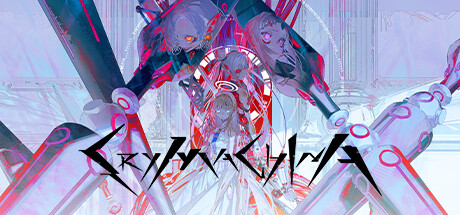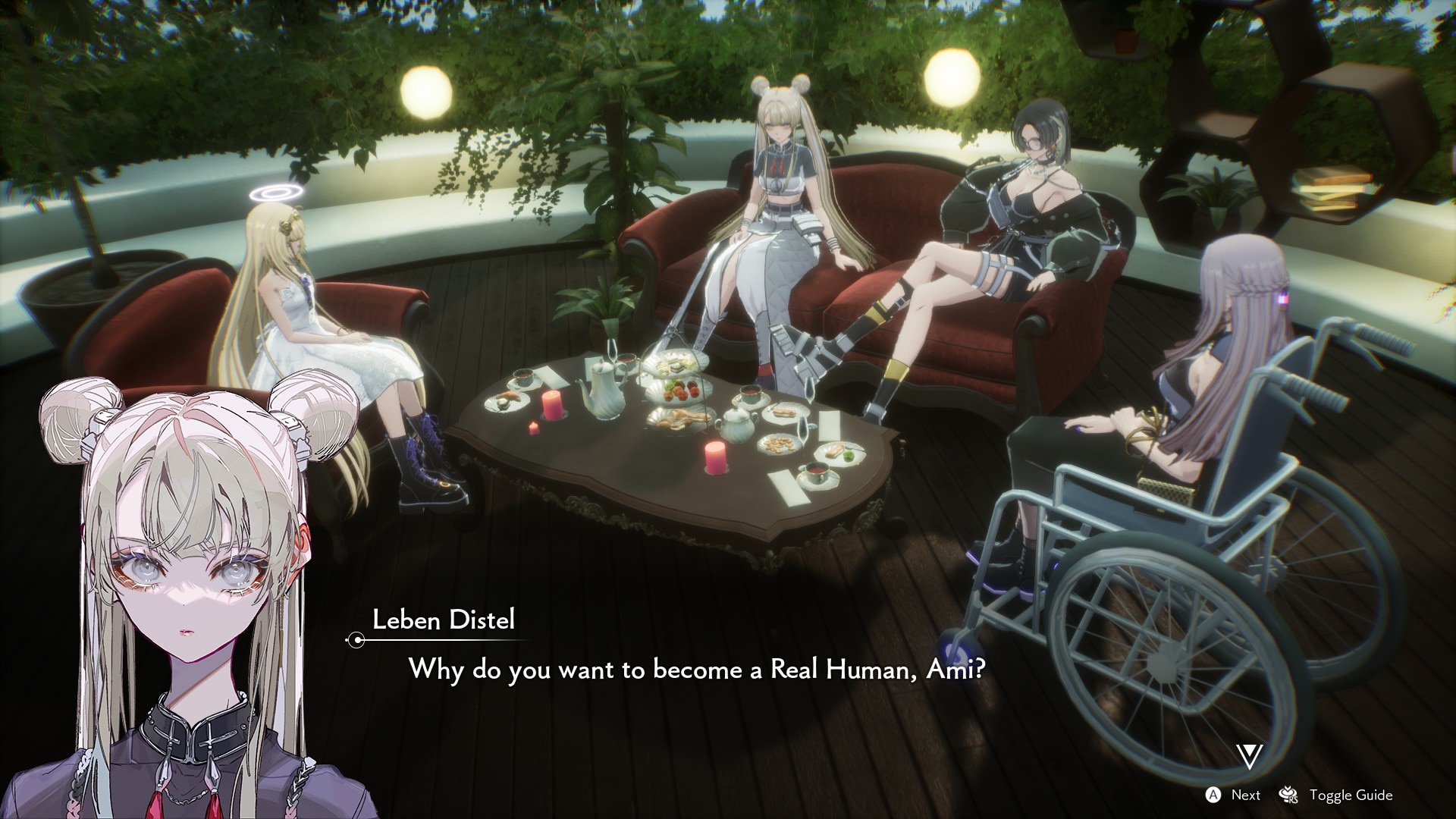
CRYMACHINA
Much like its predecessor Crystar, Crymachina is a story-driven action RPG with great visuals and flavorful anime characters, and overall a game with lots of emotion and personality. Some say that Crymachina is a much-improved version of Crystar, but as someone who played through both games one after another, I beg to differ. Each of them has its own strengths and weaknesses, and picking a favorite among those two is rather difficult.
Story
The two games have unrelated stories and can be played individually from each other. While Crystar’s story is a personal one (the protagonist journeys through purgatory to find her younger sister’s soul and bring her back to life), Crymachina’s narrative takes place on a grander scale in a futuristic setting, even if it’s not quite a space opera. Crymachina’s core message is also deeply impactful: humanity is not given by being born as a human, but by having a heart, a soul that loves and protects the ones that it cares for.

Two thousand years ago, an unknown disease with a 100% fatality rate and a mysterious cause wiped out more than 20% of the population. Because of resource scarcity, the rest of the population engaged in a war and eventually went extinct. In their last moments, the remaining surviving humans created a gigantic space structure (called “Eden”) in hopes of preserving their species. Eden was equipped with eight Dei ex Machina (machine gods): self-evolving, artificial life forms whose only purpose was mankind’s resurrection. The game’s storyline starts with the sudden disappearance of the first Deus ex Machina, which leads to a war for control among the other Dei ex Machinas, causing havoc on Eden. To overpower the machines, command them back into order and install peace, a “Real Human” is needed, as to machines humans are gods. For this purpose, the eighth Deus ex Machina (Enoa) revives a young human girl (Leben) by encasing her soul into a synthetic frame, essentially transforming her into a battle machine. The team led by Enoa and otherwise consisting of Leben and two other girls, (Ami and Mikoto) will try to make their way through various virtual areas of the space structure, fixing the corrupted machine code and overwriting it with Enoa’s, while also trying to gather enough ExP for Leben (the “chosen one”) to become a “Real Human”.

Gameplay
Both games use the same formula of alternating between individual missions and story bits. However, Crymachina’s story is much more ample than Crystar’s, covering most of the gameplay. The missions, which in Crystar took 30-45 minutes each, were spawned over several floors with lots of side paths and had dozens of enemies to fight, are now squeezed into very short and linear runs that usually take less than 10 minutes and end in a boss fight. Barely any enemy is encountered and every mission is basically a straight and quick path to the boss, with some of them having an optional micro puzzle that unlocks a high-level miniboss.

This 180° turn in the design might have been a response to the complaints about Crystar that the gameplay is too repetitive or boring. Personally, I find this decision to strongly downgrade the fun of the game. While the environments are extremely spacious and beautifully crafted, they’re not meant to be explored. You’re not even expected to spend much time traversing them, because there’s almost no one to fight (Crystar has at least ten times more enemies). The boss fights are rather lengthy, thus most of the “action” part of the game will be spent in the boss room. I love the visual novel aspect of the game and that roughly 75% of the time goes into reading through the story, but during the action parts of the game, my fingers were itching for some quick hack-and-slash action and unfortunately, Crymachina failed to fully satisfy this itch. It’s considered a hack-and-slash game, although… there is not nearly enough hacking and slashing.
In each of the missions, you will play as one of the three girls, with you being able to freely pick which one of them to bring into battle only during side missions or in the additional content that you can unlock after the main story ends. Unlike in Crystar, where all four playable characters were always available and you were also allowed to switch between them mid-run or even mid-fight, here the main missions are usually locked to a specific character. This means that you will have to equally level up and gear up all three girls to be able to overcome all levels / boss fights, which will require a bit of grinding.

In between missions, the girls gather for a tea party in a virtual garden, where they will chit-chat about their progress or plan their further actions. Most of these cutscenes / dialog sequences are mandatory for story progression, but there are some optional ones with some extra dialogues that add flavor to the game and help build up the characters, all of them being fully voiced. The virtual garden also acts like a main hub for the game, allowing you to transform the items collected from missions into pieces of gear (using the same “cry” mechanic from Crystar), organize your equipment, upgrade combat abilities, consult the encyclopedia of enemies and story concepts, etc.
Combat
The combat in Crymachina retains its simplicity from Crystar, which for me is one of the most enjoyable aspects of both games. Your basic melee attack and your ranged attack will fill the damage gauge of the enemies. When it’s filled, you can perform a heavy attack that downs them, followed by a finishing attack on already downed enemies. Rinse and repeat this sequence until the enemy is killed – that’s pretty much all there is to it. You can also dodge attacks by dashing away or sometimes counter them by parrying and additionally make use of three extra abilities (a heal and two damage-increase skills) that can be upgraded with the currency gathered from your runs. The difficulty of the enemies depends heavily on your level: being 2-3 levels lower makes them pretty difficult to kill (requiring lots of attacks) while being 2-3 levels higher can kill regular enemies even with one hit. The bosses hit very hard, and often you can even die after a couple of their hits even if your level matches theirs, and even on the easiest difficulty mode. It’s a game in which you have to constantly dodge the attacks, but fortunately, there’s a pretty clear visual cue that shows you when you’re expected to do that. The required reaction times are also very decent, the enemies allow you enough time to dodge their attacks as long as you’re not stunned.

Verdict
Crymachina is more of a Yuri visual novel rather than an action RPG. It’s a decent and enjoyable game, but it won’t scratch that itch of mashing buttons and seeing enemies drop dead. The visuals and the music are top-notch, the story is immersive enough (as long as you enjoy lengthy reads), and the combat is fast, fluid and to some extent effortless. Given that it’s a ~20-hour game, with around five extra hours of grinding for 100% achievement completion, I’d say that the asking price of $60 is rather steep. It’s certainly a game worth playing or wishlisting if you’re into some casual, laid-back hack-and-slash action, but it’s advisable to wait for a sale.

Which is better? Crystar or Crymachina?
| Story – core message | Crymachina | |
| Story – characters | Crymachina | their personalities are more interesting and unique |
| Story – length | Crymachina | rough estimate: 75% of the time will be spent on reading dialogues and watching cutscenes, while in Crystar it’s around 30% |
| Combat – fun | Crystar | more enemies to kill, more exploration |
| Combat – bosses | Crymachina | more interesting bosses |
| Combat – difficulty | Crystar | Crystar enemies are easier to kill and they do considerably less damage |
| Combat – repetitiveness | Crymachina | Crystar is considerably more grindy than Crymachina) |
| Combat – character flexibility | Crystar | free to switch to another character, even in mid-fight |
| Combat – controls | Crystar | selecting which ability to trigger during a fight is too inconvenient in Crymachina |
| Menu navigation | Crymachina | Crystar has very confusing and cumbersome way to navigate menus, especially for equipment upgrades |
| Environment design | Crymachina | Crymachina’s spacious areas are extremely beautiful, although they don’t leave space for exploration |
| Visuals | Both | both have very nice 3D anime style artwork |
| Voice-overs | Both | both have very good voice acting |
| Music | Crymachina |
You are invited to read my review for Crystar if you’d like to find out more about it.